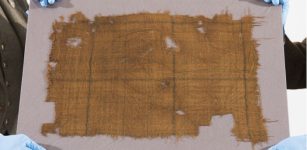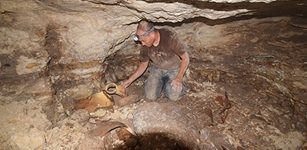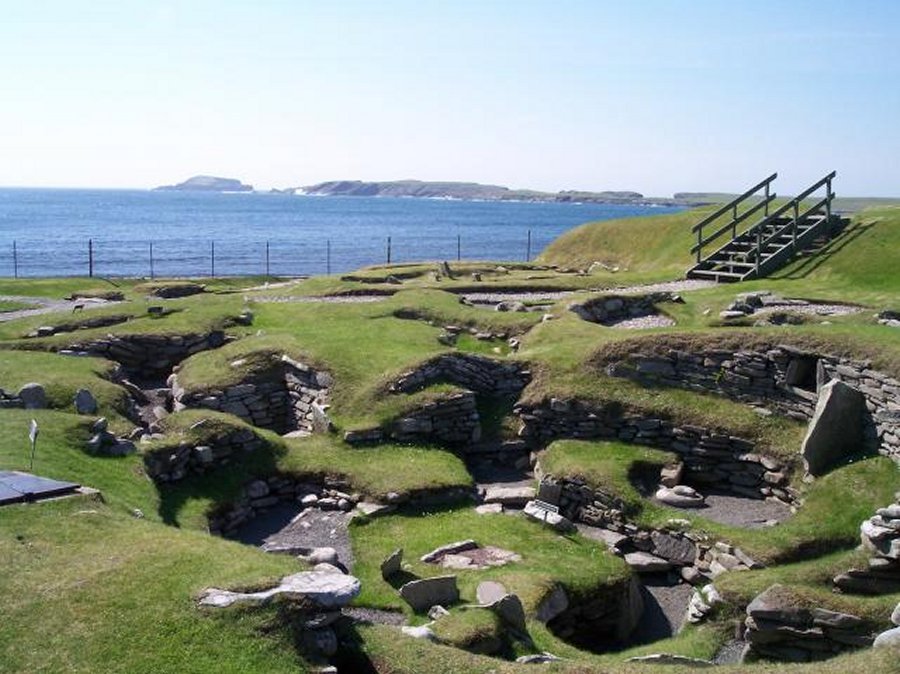History Of Jarlshof – Thousands Of Years Of History With Traces Of Picts, Vikings And Scots
A. Sutherland - AncientPages.com - Jarlshof is an ancient settlement near Sumburgh Head, the southern tip of the Shetland Mainland in northern Scotland.
It is one of the most unique and famous prehistoric archaeological sites ever excavated in the British Isles and Scotland. It embraces more than 4,000 years of human history.
Jarlshof, Grutness, Shetland Islands, Scotland, Great Britain. Image credit: Nigel Duncan - CC BY-SA 2.0
It was home to many different people for a very long time. Excavations revealed late Neolithic stone houses, Bronze-Age village, Iron-Age broch and wheelhouses, Norse longhouse, medieval farmstead, 16th-century Scottish laird's house, and a great variety of artifacts dating from 2500 BC up to the 17th century AD.
Based on the evidence, technologies developed throughout the period. Buildings - low, solid stone structures with roofs possibly built of turf or wood remained oval-circular. Their internal space did not have many variations. However, the buildings were gradually modified many times. Each new generation often re-used the stones from older buildings, leading to a complex series of structures.
In addition to their crops and livestock, the people may have utilized fish, shellfish, birds, and seals as food and other items for daily living. The Bronze Age introduced ponies; from the Iron Age onwards, pigs, oats, and cats appeared.
How Did Ancient People Live At Jarlshof?
Spindle whorls and weaving tools were not found until the Iron Age, suggesting textile production started then.
 Painted pebbles from Keiss, Caithness; Broch of Burrian, North Ronaldsay, Orkney; Jarlshof, Shetland. Date: 200-800 AD. National Museums Scotland Project.
Painted pebbles from Keiss, Caithness; Broch of Burrian, North Ronaldsay, Orkney; Jarlshof, Shetland. Date: 200-800 AD. National Museums Scotland Project.
Earlier, clothes were possibly made of leather. Excavations of Iron Age structures exposed a large souterrain (underground passage and chamber) over 6m long, demonstrating considerable engineering skills.
These underground spaces were probably used for storage of next year's seed corn and cold storage of perishable food.
The name 'Jarlshof ' (means 'Earl's mansion') was given to this ancient site by Sir Walter Scott when he was writing 'The Pirate,' a novel in which he refers to a fictional house based on the 16th-century laird's house, the Old House of Sumburgh.
At Jarlshof, people lived for more than 4000 years, but how did they live? What was their life in the windy, cloudy climate with rain falling on more than 250 days a year?
Remains of Jarlshof unveil all kinds of settlements, wheelhouses, roundhouses, longhouses, manor houses; from the Stone Age to the end of the 17th century. Photo source
People whose life focused on farming raised pigs, sheep, cattle, and ponies. Fishing became a significant activity, and barley and oats were also grown. Many domestic items were forged out of iron, carved from bone or antler, or sculpted from local steatite or soapstone.
Why did the ancients live in this particular place close to the Atlantic Ocean?
Jarlshof lay on fertile, well-drained slopes close to sheltered harbors with freshwater springs nearby. The Bronze Age settlers from over 4000 years ago left evidence of tiny, oval houses (thought to have been partly underground at the time of construction ) with thick stone walls and various artifacts from times long gone. Two opposing door openings faced away from the wind.
The remnants found at Jarlshof represent millennia of human settlement in Shetland. The earliest-dated artifacts found at the site were
Neolithic pottery unearthed at the site is over 5000 years old; however, the earliest structures in the area of the archaeologists date back to around 2000BC.
The earliest remains on the site are late Neolithic houses, followed by Bronze Age houses, two of which have underground passages attached, known as souterrains. These may have served as cold stores. Third souterrain curls beneath the hearth of one of the buildings and might have been for keeping grain dry. Photo: Shetland Heritage And Culture
The Iron Age ruins include several different structures, including a broch, found only in Scotland, with two outer walls and a defensive wall around the site.
Jarlshof And The Viking Connection
Over the years, the typical Viking longhouses developed, with a kitchen, living hall, and a cowshed at the lower end, all made from stone and turf.
Objects found at Jarlshof such as bronze jewelry, net weights, games, and drawings reveal that the Norse were farmers, fishermen, craftsmen, and raiders.
The remains of up to 16 generations of Viking longhouses, made from stone rather than the usual wood, are still visible at ancient Jarlshof, which was a self-sufficient farm. Other buildings include a bath-house, kiln for drying corn, blacksmith's workshop, several roads, and pavements.
Jarlshof settlement is the most extensive site of Viking remains in Britain. By the 13th century, a medieval farmhouse replaced the longhouses, showing the change in society. After Shetland passed to Scotland in 1496, a Scottish Lairds house was built on the site and became the central structure. It was called the Old House of Sumburgh, Old Norse borg, which means "fort."
Written by A. Sutherland - AncientPages.com Staff Writer
Updated on August 16, 2022
Copyright © AncientPages.com. All rights reserved. This material may not be published, broadcast, rewritten or redistributed in whole or part without the express written permission of AncientPages.com
Expand for referencesMore From Ancient Pages
-
 God Dagda – A Powerful Leader Of The Tuatha De Danann In Celtic Mythology
Celtic Mythology | May 30, 2020
God Dagda – A Powerful Leader Of The Tuatha De Danann In Celtic Mythology
Celtic Mythology | May 30, 2020 -
 Scotland’s Oldest Tartan On Display For The First Time!
Artifacts | Apr 6, 2023
Scotland’s Oldest Tartan On Display For The First Time!
Artifacts | Apr 6, 2023 -
 Large, High-Elevation Cities Along Asia’s Silk Roads Exposed By High-Res Lidar
Archaeology | Oct 23, 2024
Large, High-Elevation Cities Along Asia’s Silk Roads Exposed By High-Res Lidar
Archaeology | Oct 23, 2024 -
 Charles VI Of France – The King Who Was Made Of Glass
Featured Stories | Jan 22, 2016
Charles VI Of France – The King Who Was Made Of Glass
Featured Stories | Jan 22, 2016 -
 Ancient Armenia Remains A Country Full Of Secret History
Civilizations | Sep 25, 2015
Ancient Armenia Remains A Country Full Of Secret History
Civilizations | Sep 25, 2015 -
 Egyptian ‘Golden Boy’ Mummy Was Protected By 49 Precious Amulets On His Journey To The Afterlife – CT Scans Reveal
Archaeology | Jan 24, 2023
Egyptian ‘Golden Boy’ Mummy Was Protected By 49 Precious Amulets On His Journey To The Afterlife – CT Scans Reveal
Archaeology | Jan 24, 2023 -
 Sumerians Built A Huge ‘Anti-Drought Machine’ To Save Ancient City Of Girsu From Destruction
Ancient Technology | Nov 23, 2023
Sumerians Built A Huge ‘Anti-Drought Machine’ To Save Ancient City Of Girsu From Destruction
Ancient Technology | Nov 23, 2023 -
 Mysterious Unknown Beings Who Walked The Earth With Humans
Ancient Mysteries | Sep 15, 2020
Mysterious Unknown Beings Who Walked The Earth With Humans
Ancient Mysteries | Sep 15, 2020 -
 LIDAR Will ‘Map’ The Ground Surface To Reveal New Picture Of Ancient Native American Culture
Archaeology | Aug 18, 2023
LIDAR Will ‘Map’ The Ground Surface To Reveal New Picture Of Ancient Native American Culture
Archaeology | Aug 18, 2023 -
 Long-Lost Ancient Tomb Of ‘China’s Shakespeare’ Finally Found
Archaeology | Aug 31, 2017
Long-Lost Ancient Tomb Of ‘China’s Shakespeare’ Finally Found
Archaeology | Aug 31, 2017 -
 Draken Harald Hårfagre – World’s Largest Viking Ship On Its Way To U.S And Canada
News | Apr 27, 2016
Draken Harald Hårfagre – World’s Largest Viking Ship On Its Way To U.S And Canada
News | Apr 27, 2016 -
 LIDAR Advanced Technology Spotted Rare Pre-Columbian Florida Village – Highly-Prized Producer Of Beads
Archaeology | Nov 10, 2019
LIDAR Advanced Technology Spotted Rare Pre-Columbian Florida Village – Highly-Prized Producer Of Beads
Archaeology | Nov 10, 2019 -
 The Cyclades And Their Mysterious Society Lost In Time
Civilizations | Feb 4, 2016
The Cyclades And Their Mysterious Society Lost In Time
Civilizations | Feb 4, 2016 -
 Collapse Of Akkadian Empire Strongly Related To Catastrophic Climate Change
Archaeology | Oct 28, 2019
Collapse Of Akkadian Empire Strongly Related To Catastrophic Climate Change
Archaeology | Oct 28, 2019 -
 Massive 2nd-Century Fountain In Turkey’s Ancient City Of Tripolis Will Be Soon Restored
Archaeology | Aug 3, 2020
Massive 2nd-Century Fountain In Turkey’s Ancient City Of Tripolis Will Be Soon Restored
Archaeology | Aug 3, 2020 -
 183-Million-Year-Old Fossils: Jurassic Marine World In A Farmer’s Field
Fossils | Jul 31, 2022
183-Million-Year-Old Fossils: Jurassic Marine World In A Farmer’s Field
Fossils | Jul 31, 2022 -
 Ancient Cities Built By Biblical Giants – Archaeological Evidence
Ancient Mysteries | Jun 2, 2018
Ancient Cities Built By Biblical Giants – Archaeological Evidence
Ancient Mysteries | Jun 2, 2018 -
 Lost Knowledge Of Energy And Crystal Technology In Ancient Egypt
Ancient Mysteries | May 17, 2019
Lost Knowledge Of Energy And Crystal Technology In Ancient Egypt
Ancient Mysteries | May 17, 2019 -
 A 2000-Year-Old Jewish Settlement Near Bet Shemesh – Unearthed
Archaeology | Mar 30, 2017
A 2000-Year-Old Jewish Settlement Near Bet Shemesh – Unearthed
Archaeology | Mar 30, 2017 -
 First-Ever Discovery Of Roman Road Network Spanning The South West UK Made By LIDAR
Archaeology | Aug 7, 2023
First-Ever Discovery Of Roman Road Network Spanning The South West UK Made By LIDAR
Archaeology | Aug 7, 2023



